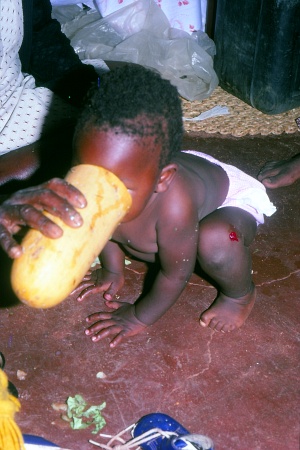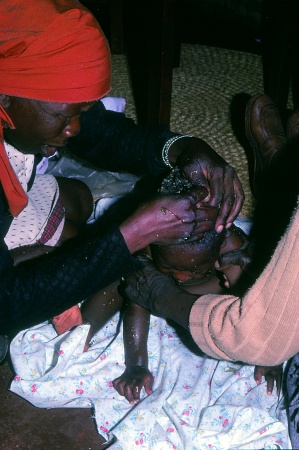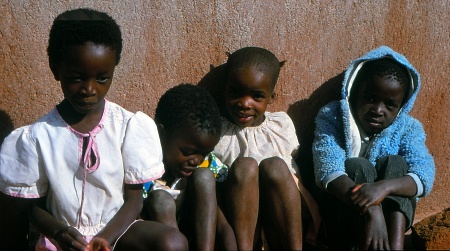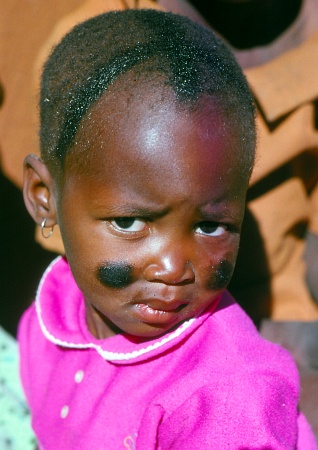© 2023 Dr Margaret Sheppard
2. Moalafi - The Healer and Remedies
Apart from these herbalists there are also people who specialise in healing one or two conditions. Such a person is referred to as a Moalafi -
There is also a woman who is famous for her skill in purifying the widowed. Like traditional doctors they receive fees for their cures. More details of their methods will be given below in the section on Tswana remedies.
It should be noted that when a person is ill and they decide to use traditional medicine they may go to a tradtional doctor, a Moalafi or a herbalist (including the pharmacy). Their choice will depend largely on the reputation of the healer for that articular disease.
It should also be remembered that according to Tswana philosophy, the sickness is often seen as a symptom of another problem caused by other agents, for example, the action of sorcery, dissatisfaction of Ancestors, or dikgaba; Therefore if symptoms persist then an individual will consult a traditional doctor, who will throw his bones to divine the cause. Thus, in this type of case the aim of the cure is not only to heal the symptom but also to protect the patient against any further actions of the causer(s).
1 Tlhowana (fontanelles) specialist
This is a very common disease seen in young children. This is diagnosed when it is noticed that the baby or young child is seen to be confused and its fontanelles are observed not to close up properly. If it is not cured the child will grow up to be mentally disturbed or may have poor sight or even die. This condition is said to be caused by the large intestine "not being well-
If this condition is left untreated the air might eventually push out the umbilical cord, making it burst. This may even kill the child. Untreated tlhowana can lead to poor sight and headaches. It is popularly believed that this is the reason why so many white people have to wear glasses, as their doctors did not know how to treat tlhowana!
Medicines to cure this disease can be smeared on the babies heads daily along the fontanelles that are seen to be affected. They may also be smeared over the whole body. These are usually the so-
There are various plants that are believed to be helpful for children suffering from tlhowana. I saw three different ones,that had small flowers and were growing along a river course in the village. (It should also be noted that the protruding umbilical cord in a child may be caused by the mother or the father sleeping with another person whilst the baby is still suckling, or by another person using the mother's or baby's utensils or food whilst they are still in confinement.)
A Tlhowana Healer
I was fortunate to witness a tlhowana Moalafi at the completion of one of her cases. The child aged about 18 months, had started her cure in June 1981. By November she was cured and beer was brewed for the Moalafi. During its preparation no one was allowed to taste it at any of its various stages. When it was ready, the woman was called and came after dark. The woman mixed a calabash of the beer with some of her curing medicines and the child was the first to drink it.
Then the child was set down upon a new piece of cotton cloth (about half a metre). She was naked. Then the lady first rubbed her hair with a new bar of Sunlight soap alternating with the beer mixed with the medicines. Then the rest of her body was washed in the same way. Then she started to shave off the child’s hair with a new razor blade, rubbing in more of the beer and medicines and soap from time to time.
All the hair was carefully collected inside the cloth and after the job was finished all the hair mixed with the medicines was scraped off the floor and put in the cloth. Throughout the hair cutting, all the spectators had to sit down.
The rest of the pot of beer was then strained and poured into the woman's 10 litre plastic container. She was given all the various sediments from the various stages of preparation. She gave the grand-
On her way home she threw away the hair behind her, without looking backwards; this was to signify throwing away the disease from the child.
Besides the cloth and "tools", her fee was P1O. Apparently she was taught this technique of curing tlhowana by her mother who was taught it by her own father, a traditional doctor. She told me that in addition she could cure nose bleeding.







Healer mixing medicines in specially brewed beer
The child must be the first to drink it
Healer seats the child on the new cloth and washes her with the sunlight soap and beer mixed with the medicines.
The child’s hair is then cut with the new razor blade, by the healer
On completion, the healer gathers up all the child’s hair in the cloth. She will throw this behind her on her way home. She also takes the razor blade and soap, beer and all the beer sediments with her as part of her fee for the cure.
A Tlhowana Child’s hair is not cut along the fontanelles until it is cured. Sometimes two ends of hair are twisted into “horns” as the child above. Or black medicines are applied daily along the fontanelles and on the cheeks as the child on the right.
2)Curing the umbilical cord of new born babies
Various traditional herbal medicines are given to a new born baby to heal its umbilical cord. Many people know these and they are not necessarily administered on the directions of a traditional doctor or Moalafi. One such is called masokela tsebeng which has one round leaf above ground and the underground tuberous root is used. This is boiled and administered to the baby 3-
As with all traditional medicines, no one else is allowed to touch it.
The patient was instructed to boil these separately and drink them 3 or 4 times a day, before her next menstruation. They had to be boiled, like all traditional medicines, in an open pot to let out the evil spirits. Then when her next menstruation came she had to take a few drops of the menstrual blood and keep it in a small bottle and give it to the woman, who was then going to bury it where she had dug the "wild onion". She emphasized that no one other than the patient was to touch these medicines -

3:Menstrual Pains
The sufferer was aged about 28 and had long suffered from this condition. She had heard from other women who had been successfully cured, of a good Moalafi. The woman had learnt her skill from her father who had been a famous traditional doctor in the Hurutshe area in South Africa. In this particular case she gave her patient a certain "wild onion" and some ground up medicine.
4)Venereal Diseases
Men are believed to develop a venereal disease that is probably gonorrhoea through sleeping with women who are menstruating. One traditional doctor explained this disease to me by saying that the man feels the pain of this disease in the umbilical cord and then the blood passes from the umbilical cord into the spinal cord. As soon as it enters here, it will go via veins and arteries to bring the pain to the head. This makes the person mentally disturbed and even mad.
The doctor will use ditaola (bones) to “see” the kind of herbs to use to cure the person. If the disease is very bad he may have to use the intestine of a goat or sheep and wrap it around the medicines when he is boiling them. This is because this is the part that is loose in the patient and so it is to make it become stronger to help that part to come together. By boiling these medicines several times for the patient the patient will have diarrhoea and this will help to dehydrate the blood from the spinal cord that has caused the disease. In this way the madness comes out of the person and he is healed.
5)Fractures
These are often believed to be caused by Sorcerers. Thobega (setting fractures) is a speciality. The traditional doctor will splint the broken bones, and then often wrap strings of beads, especially mixtures of ostrich egg shell beads and porcupine spines, around the fracture. The patient will also be “washed” to protect him/her against his/her attacker. One way these are commonly caused is through the attacker bewitching a person's footprints. The sorcerer takes earth from the footprint is to mix with bewitching medicines, which is why such a patient must be “washed” to be protected from further harm.
6)Hepatitis
/
This supposedly can be cured by various healers. Some traditional doctors can cure it, but a certain woman living near Kwakwe Hill was well-
In 1981 the father of another of my informants died of the disease. The relatives who were blamed for bewitching him were supposed to have bewitched the Moalafi to refuse to cure him.
7) Alcoholism
Certain traditional doctors in Kanye were believed to have the cure for this. I knew of three such specialists who were believed to be able to cure advanced alcoholics. The brother of one of my informants was cured of this disease by one of these practitioners.
Alcoholism is often believed to be a symptom of having been bewitched. There are many cases of people who, for example, after successfully completing education at a high level are bewitched to become alcoholics. The sorcerers are probably jealous of the family as better education usually leads to family advancement through better paid employment and increased family wealth.
The specialist traditional doctor first throws the bones to find the cause and gives the sufferer a special herbal mixture. This is mixed with his next alcoholic drink and has the effect of making him vomit badly. After this he is supposed to refuse to take alcohol again. The sufferer I observed was taken by his father after spending some years as a hopeless drunkard (having been bewitched to become so by some jealous people of his kgotla).
He took the cure in April 1971 and by February 1983 he had still not returned to alcohol. The fee in this case was P20 (i.e. approximately equivalent to the price of a goat.)
8)Mumps (Makidiane)
When a person has this they are isolated from adolescent boys and girls as the disease is believed to cause sterility. Then every morning the sufferer must call into a big clay pot:
"Makidiane. Boela nkgwaneng." (Mumps go back into the pot).
They do this several times. This is believed to reduce the swelling which returns to the clay pot where it belongs. Presumably the shape of a clay pot is believed to be connected with the shape of a sufferer's swellings.
9)Measles (Sompane)
A sufferer is supposed to be kept in the house. Then they go outside and step on certain 5-
Another cure is to go to the goat kraal and take goat's droppings. Individual droppings are then put in a circle alternately with the above-
Another cure is to slaughter a goat and then the grass from its stomach is rubbed over the rash to reduce irritation.
IO)Ante- and post-natal care
Maburu (Coloured) women of Go-
Another Maburu woman prays on women who are barren and massages them to have babies etc. I am not quite sure where this power is believed to come from but it is probably God rather than Ancestors -
11)Physical Disabilities
Several physical disabilities may be attributed to the action of sorcerers or the breaking of taboos (meila). For example, females and children are not supposed to see kittens and puppies before their eyes are open or they will go blind. Pregnant women should not eat ground nuts from their shells as this leads to the birth of babies with narrow eyes like the shells of ground nuts, nor should pregnant women cross pieces of wood -